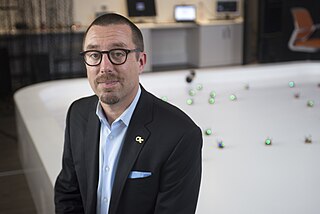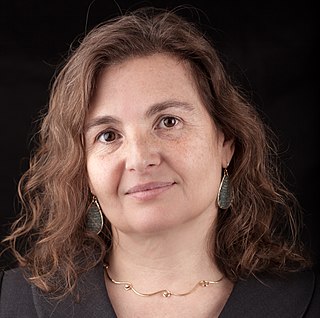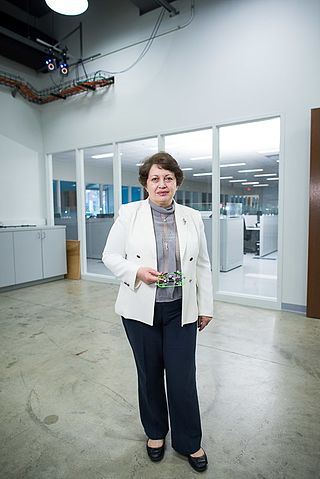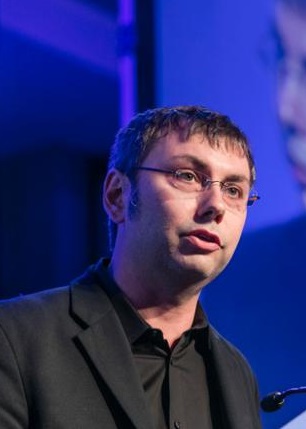Related Research Articles

An underwater glider is a type of autonomous underwater vehicle (AUV) that employs variable-buoyancy propulsion instead of traditional propellers or thrusters. It employs variable buoyancy in a similar way to a profiling float, but unlike a float, which can move only up and down, an underwater glider is fitted with hydrofoils that allow it to glide forward while descending through the water. At a certain depth, the glider switches to positive buoyancy to climb back up and forward, and the cycle is then repeated.

A mobile robot is an automatic machine that is capable of locomotion. Mobile robotics is usually considered to be a subfield of robotics and information engineering.

The Deep Phreatic Thermal Explorer (DEPTHX) is an autonomous underwater vehicle designed and built by Stone Aerospace, an aerospace engineering firm based in Austin, Texas. It was designed to autonomously explore and map underwater sinkholes in northern Mexico, as well as collect water and wall core samples. This could be achieved via an autonomous form of navigation known as A-Navigation. The DEPTHX vehicle was the first of three vehicles to be built by Stone Aerospace which were funded by NASA with the goal of developing technology that can explore the oceans of Jupiter's moon Europa to look for extraterrestrial life.

Magnus B. Egerstedt is a Swedish-American roboticist who is the Dean of the Henry Samueli School of Engineering at the University of California, Irvine. He was formerly the Steve C. Chaddick School Chair and Professor at the School of Electrical and Computer Engineering, Georgia Institute of Technology.

Mark W. Spong is an American roboticist. He is a professor of systems engineering and electrical and computer engineering in the Erik Jonsson School of Engineering & Computer Science at the University of Texas at Dallas (UTD). He served as dean of the Jonsson School and the Lars Magnus Ericsson Chair in Electrical Engineering from 2008 to 2017. Before he joined UTD, he was the Donald Biggar Willett Professor of Engineering, professor of electrical engineering, research professor of Coordinated Science Laboratory and Information Trust Institute, and director of Center for Autonomous Engineering Systems and Robotics at the University of Illinois at Urbana-Champaign.

Daniela L. Rus is a roboticist and computer scientist, Director of the MIT Computer Science and Artificial Intelligence Laboratory (CSAIL), and the Andrew and Erna Viterbi Professor in the Department of Electrical Engineering and Computer Science (EECS) at the Massachusetts Institute of Technology. She is the author of the books Computing the Future and The Heart and the Chip.
John J. Leonard is an American roboticist and Professor of Mechanical and Ocean Engineering at the Massachusetts Institute of Technology. A member of the MIT Computer Science and Artificial Intelligence Laboratory (CSAIL), Leonard is a researcher in simultaneous localization and mapping, and was the team lead for MIT's team at the 2007 DARPA Urban Challenge, one of the six teams to cross the finish line in the final event, placing fourth overall.
Maurizio Porfiri is an engineering professor, mostly noted for his work with robotic fish and aquatic research. His research revolves around modeling and control of complex systems, with applications from mechanics to behavior, public health, and robotics. He is an Institute Professor of Mechanical and Aerospace Engineering and Biomedical Engineering at the New York University Tandon School of Engineering. He is also part of the core faculty of New York University's Center for Urban Science and Progress. In 2022, he was appointed the director of the Center for Urban Science and Progress.

Promode R. Bandyopadhyay is an Indian born American inventor, research scientist and Technical Program Manager at the Naval Undersea Warfare Center, Newport, Rhode Island, USA. He was a Program Officer at the Cognitive, Neural and Biomolecular Science and Technology Division of the Human Systems Science and Technology Department of the Office of Naval Research (2000–2002). He was a Post-Doctoral Researcher at Cambridge University Engineering Department and University of Houston.

Naira Hovakimyan is an Armenian control theorist who holds the W. Grafton and Lillian B. Wilkins professorship of the Mechanical Science and Engineering at the University of Illinois at Urbana-Champaign. She is the director of AVIATE Center of flying cars at UIUC, funded through a NASA University Leadership Initiative. She was the inaugural director of the Intelligent Robotics Laboratory during 2015–2017, associated with the Coordinated Science Laboratory at the University of Illinois at Urbana-Champaign.

Yoram Koren is an Israeli-American academic. He is the James J. Duderstadt Distinguished University Professor Emeritus of Manufacturing and the Paul G. Goebel Professor Emeritus of Engineering at the University of Michigan, Ann Arbor. Since 2014 he is a distinguished visiting professor at the Technion – Israel Institute of Technology.

The Annual Review of Control, Robotics, and Autonomous Systems is an annual peer-reviewed scientific journal published by Annual Reviews. In publication since 2018, the journal covers developments in the engineering of autonomous and semiautonomous systems through an annual volume of review articles. It is edited by Naomi Ehrich Leonard. As of 2023, Annual Review of Control, Robotics, and Autonomous Systems is being published as open access, under the Subscribe to Open model. As of 2023, Journal Citation Reports gives the journal an impact factor of 13.4 for the year 2022, ranking it first of 65 journal titles in the category "Automation and Control Systems" and second of 30 journal titles in the category "Robotics".

Silvia Ferrari is an Italian-American aerospace engineer. She is John Brancaccio Professor at the Sibley School of Mechanical and Aerospace Engineering at Cornell University and also the director of the Laboratory for Intelligent Systems and Control (LISC) at the same university.
Dawn Marie Tilbury is an American control theorist whose research topics include logic control, networked control systems, robotics, human–machine systems, and autonomous vehicles. She is a professor of mechanical engineering and of electrical engineering and computer science at the University of Michigan, and the head of the directorate for engineering at the National Science Foundation.
Sonia Martínez Díaz is a Spanish mechanical engineer whose research applies control theory to the coordinated motion of robot swarms and mobile wireless sensor networks. She is a professor in the Department of Mechanical and Aerospace Engineering at the University of California, San Diego.

Ryan M. Eustice is an American roboticist, and the Senior Vice President of Human-centric AI and Technology Adoption at the Toyota Research Institute (TRI). He is also a Professor of Robotics and Naval Architecture & Marine Engineering at the University of Michigan.
Marcia Kilchenman O'Malley is an American mechanical engineer, the Thomas Michael Panos Family Professor in Mechanical Engineering and associate dean for research and innovation for the George R. Brown School of Engineering at Rice University. Her research concerns "systems for enhancing the human sensorimotor control system", including work on exoskeletons, neuroprosthetics, haptic technology, and brain–computer interfaces.

Ali Galip Ulsoy is an academic at the University of Michigan (UM), Ann Arbor, where he is the C.D. Mote Jr. Distinguished University Professor Emeritus of Mechanical Engineering and the William Clay Ford Professor Emeritus of Manufacturing.

Moshe Shoham is a professor emeritus in the faculty of mechanical engineering at the Technion - Israel Institute of Technology.
Alison B. Flatau is an American aerospace engineer whose research involves smart materials and magnetostriction, changes in the physical shape of materials under magnetic fields, and in the application of nanowires built from these materials in controlling the flight of micro air vehicles. She is a professor and department chair of the Department of Aerospace Engineering in the A. James Clark School of Engineering at the University of Maryland, College Park.
References
- 1 2 3 "Clark School alum Naomi Leonard named MacArthur Fellow". University of Maryland. September 27, 2004. Retrieved 15 September 2021.
- 1 2 3 "Leonard Lab". Princeton University. Retrieved 15 September 2021.
- ↑ Allen, Liz (June 1, 2018). "Annual Reviews publishes first multidisciplinary autonomous systems review journal". Annual Reviews News. Retrieved 14 September 2021.
- ↑ Leonard, Naomi E. (1994). "Averaging and Motion Control of Systems on Lie Groups". DRUM: Digital Repository at the University of Maryland. Retrieved 15 September 2021.
- ↑ "Naomi Leonard Engineer : Class of 2004". MacArthur Foundation. Retrieved 15 September 2021.
- 1 2 Naomi Ehrich Leonard - Princeton Mechanical and Aerospace Engineering .
- ↑ Flexas, Mar M.; Troesch, Martina I.; Chien, Steve; Thompson, Andrew F.; Chu, Selina; Branch, Andrew; Farrara, John D.; Chao, Yi (March 2018). "Autonomous Sampling of Ocean Submesoscale Fronts with Ocean Gliders and Numerical Model Forecasting". Journal of Atmospheric and Oceanic Technology. 35 (3): 503–521. Bibcode:2018JAtOT..35..503F. doi: 10.1175/JTECH-D-17-0037.1 .
- ↑ Fiorelli, Edward; Leonard, Naomi Ehrich; Bhatta, Pradeep; Paley, Derek A.; Bachmayer, Ralf; Fratantoni, David M. (2006), "Multi-AUV Control and Adaptive Sampling in Monterey Bay" (PDF), IEEE Journal of Oceanic Engineering, 31 (4): 935, Bibcode:2006IJOE...31..935F, doi:10.1109/JOE.2006.880429, S2CID 4803872 , retrieved 2017-02-03.
- ↑ Ramp, S.R.; Davis, R.E.; Leonard, N.E.; Shulman, I.; Chao, Y.; Robinson, A.R.; Marsden, J.; Lermusiaux, P.F.J.; Fratantoni, D.M.; Paduan, J.D.; Chavez, F.P.; Bahr, F.L.; Liang, S.; Leslie, W.; Li, Z. (February 2009). "Preparing to predict: The Second Autonomous Ocean Sampling Network (AOSN-II) experiment in the Monterey Bay". Deep Sea Research Part II: Topical Studies in Oceanography. 56 (3–5): 68–86. Bibcode:2009DSRII..56...68R. doi:10.1016/j.dsr2.2008.08.013 . Retrieved 15 September 2021.
- ↑ Song, Juwon (21 June 2017). "Interdisciplinary Panel Dives into Underwater Robotics". AAAS. Retrieved 15 September 2021.
- ↑ McLeish, Tom (January 10, 2019). The poetry and music of science : comparing creativity in science and art (First ed.). Oxford, United Kingdom: Oxford University Press. ISBN 9780198797999 . Retrieved 15 September 2021.
- ↑ "Trustees name nine to tenure". Princeton Weekly Bulletin. April 19, 1999. Retrieved 15 September 2021.
- ↑ "2007 IEEE CSS Awards Ceremony (Excerpt)" (PDF). IEEE Controls Systems Magazine. 2008. p. 100. Retrieved 15 September 2021.
- ↑ "ASME Fellows list" (PDF). ASME. Retrieved 2022-05-14.
- ↑ SIAM Fellows: Class of 2012 , retrieved 2015-09-09.
- ↑ IFAC Fellows